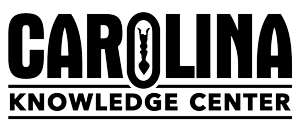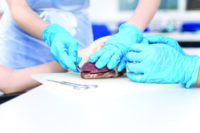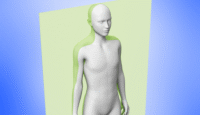Sea Floor Spreading-Divergent Plate Boundaries
A Carolina EssentialsTM Activity

Total Time: 40-50 mins
Prep: 15-20 mins | Activity: 40-50 mins

Earth and Space Science
9-12
High School
- Total Time: 40-50 minutes [ Prep: 15-20 mins | Activity: 40-50 mins ]
- Subject: Earth and Space Science
- Grade: High School
Overview
This is a student modeling activity for divergent plate boundaries that illustrates the surface and internal processes occurring at divergent plate boundaries. The model is used for evidence to explain surface and ocean floor features at the Atlantic Ridge and the students are asked to extend the model to explain surface features of the Great African Rift Valley. The activity may be completed by small groups of students, pairs of students, or individually. The materials required even allow for the activity to be completed at home.
Phenomenon
What internal and surface geologic processes are at work here?

Essential Question
How do surface features provide evidence of Earth’s internal processes?
Activity Objectives
- Construct a model of sea floor spreading.
- Explain surface features in Iceland based on your sea floor spreading model.
Next Generation Science Standards* (NGSS)
PE HS-ESS2-1. Develop a model to illustrate how Earth’s internal and surface processes operate at different spatial and temporal scales to form continental and ocean-floor features.
SCIENCE & ENGINEERING PRACTICES
Developing and Using Models
- Develop a model based on evidence to illustrate the relationships between systems or between components of a system.
DISCIPLINARY CORE IDEA
ESS2.A: Earth Materials and Systems
- Earth’s systems, being dynamic and interacting, causes feedback effects that can increase or decrease the original changes.
ESS2.B: Plate Tectonics and Large-Scale System Interactions
- Plate tectonics is the unifying theory that explains the past and current movements of the rocks at Earth’s surface and provides a framework for understanding its geologic history. Plate movements are responsible for most continental and ocean-floor features and for the distribution of most rocks and minerals within Earth’s crust.
CROSSCUTTING CONCEPTS
Stability and Change
- Change and rates of change can be quantified and modeled over very short or very long periods of time. Some system changes are irreversible.
Materials
- Sheet of card stock
- Tissue paper
- White printer paper
- Ruler
- Scissors
- Transparent tape
- 2 pens, pencils, or markers(different colors)
Safety Procedures and Precautions
No PPE required. Remind students of proper use of scissors.
Teacher Preparation and Disposal
Copy or upload the student activity sheets. If time is a concern, you may wish to pre-cut the tissue paper, copy paper strips, and card stock. Models can be saved for additional classes or the materials can be recycled.
STUDENT PROCEDURES
-
- Fold the paper in half lengthwise, twice. Unfold the paper and cut along the crease lines making 4-11 inch strips. Tape the 4 strips together making one- 44 inch strip.
- Cut out a 4 inch square of tissue paper. In the center of the square, cut a slit the exact width of the strip of paper. Mark the ends of the slit with a half inch line.
- Cut a 3 inch square from the center of the card stock.
- Securely tape the tissue paper over the square in the card stock.
- Fold the 44 inch strip of copy paper in half to make a double 22 inch piece. Do not crease the paper.
- Insert the ends of the copy paper into the tissue paper slit until 1 inch of paper is above the slit. Hold the card stock up so the paper strip hangs freely. Sketch the model and label what each piece represents.
- Slide the paper strip up 3 inches. Gently separate the strip into 2 pieces. Color the inside faces of the strips the same color.
- Push the paper strip up an additional 3 inches. Select a second color and color the uncolored sections of the inside faces of the strips. Sketch and label the model.
- Repeat steps 7 and 8 until the paper strip has been pulled through the slit in the tissue paper. Sketch the final model, paying close attention to any changes in the tissue paper.
- Use the paper cover to block all the flashlight and repeat the observation.


TEACHER PREPARATION AND TIPS
- If you are using individual components and not the kit, sort the components into a basket for students to ensure they have all the correct parts.
- The slit in the tissue paper must provide a tight fit. The tissue should tear at both ends as the paper strip is pulled through, indicating an elongation of the fissure.
- In lieu of sketching the model, students can take and upload pictures, then label the pictures.
Data and Observations
Model Development
Initial Model: Sketch and Label
This step models the initial upwelling of magma through a weak, thin section of the Earth’s crust.
Intermediate Model: Sketch and Label
The strip of paper now represents lava flow from the fissure outward. Old lava is being pushed away from the fissure as new eruptions take place.
Final Model: Sketch and Label
In the final model the paper strip should extend past the edges of the card stock base. This shows a complete cycle of magma upwelling and sea floor spreading at a divergent plate boundary and eventual recycling of rock with the return to magma at a convergent boundary. A convection current on both sides of the fissure is represented.
Analysis & Discussion
What does each type of paper represent in the model?
Copy paper strip = magma, card stock = crustal rock, tissue paper = thin, brittle crustal rock
2. The colored bands represent the Earth’s changes in magnetic field strength. How can this information be used as evidence for convection currents in the mantle?
When the magnetic bands match on opposite sides of a fissure that indicates the magma was from the same source but was pushed away from the fissure on both sides. The movement away from the fissure is an indication of a convection current.
3. Use the model you constructed for the Atlantic Ridge and apply it to explain differences and similarities between the rift valleys in Iceland and east Africa.

Both valleys are long, bounded by mountains on both sides. The valley floors are relatively flat with some evidence of lava flows. The Iceland rift valley must be younger as it is not as wide, and the rock cliffs do not show signs of much erosion. The valley walls are steep and jagged. The Great Rift Valley in Africa is much wider, and the mountain sides are smoother and vegetated indicating that the African Rift valley is older but had the same geologic origins as the Iceland Rift valley. Both features are evidence of a divergent plate boundary.
SHOP THE KIT
REFERENCE KIT
HELPFUL LINKS
VIEW MORE ESSENTIALS
*Next Generation Science Standards® is a registered trademark of Achieve. Neither Achieve nor the lead states and partners that developed the Next Generation Science Standards were involved in the production of, and do not endorse, these products.




